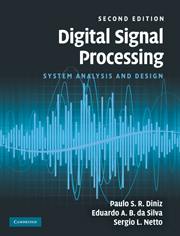Book contents
- Frontmatter
- Contents
- Preface
- Introduction
- 1 Discrete-time signals and systems
- 2 The z and Fourier transforms
- 3 Discrete transforms
- 4 Digital filters
- 5 FIR filter approximations
- 6 IIR filter approximations
- 7 Spectral estimation
- 8 Multirate systems
- 9 Filter banks
- 10 Wavelet transforms
- 11 Finite-precision digital signal processing
- 12 Efficient FIR structures
- 13 Efficient IIR structures
- References
- Index
6 - IIR filter approximations
Published online by Cambridge University Press: 05 June 2012
- Frontmatter
- Contents
- Preface
- Introduction
- 1 Discrete-time signals and systems
- 2 The z and Fourier transforms
- 3 Discrete transforms
- 4 Digital filters
- 5 FIR filter approximations
- 6 IIR filter approximations
- 7 Spectral estimation
- 8 Multirate systems
- 9 Filter banks
- 10 Wavelet transforms
- 11 Finite-precision digital signal processing
- 12 Efficient FIR structures
- 13 Efficient IIR structures
- References
- Index
Summary
Introduction
This chapter deals with the design methods in which a desired frequency response is approximated by a transfer function consisting of a ratio of polynomials. In general, this type of transfer function yields an impulse response of infinite duration. Therefore, the systems approximated in this chapter are commonly referred to as IIR filters.
In general, IIR filters are able to approximate a prescribed frequency response with fewer multiplications than FIR filters. For that matter, IIR filters can be more suitable for some practical applications, especially those involving real-time signal processing.
In Section 6.2 we study the classical methods of analog filter approximation, namely the Butterworth, Chebyshev, and elliptic approximations. These methods are the most widely used for approximations meeting prescribed magnitude specifications. They originated in the continuous-time domain and their use in the discrete-time domain requires an appropriate transformation.
We then address, in Section 6.3, two approaches that transform a continuous-time transfer function into a discrete-time transfer function, namely the impulse-invariance and bilinear transformation methods.
Section 6.4 deals with frequency transformation methods in the discrete-time domain. These methods allow the mapping of a given filter type to another; for example, the transformation of a given lowpass filter into a desired bandpass filter.
In applications where magnitude and phase specifications are imposed, we can approximate the desired magnitude specifications by one of the classical transfer functions and design a phase equalizer to meet the phase specifications.
- Type
- Chapter
- Information
- Digital Signal ProcessingSystem Analysis and Design, pp. 349 - 408Publisher: Cambridge University PressPrint publication year: 2010



